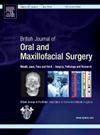How common is the extended temporomandibular joint replacement (eTMJR)? Output data from a single global producer
IF 1.9
4区 医学
Q3 DENTISTRY, ORAL SURGERY & MEDICINE
British Journal of Oral & Maxillofacial Surgery
Pub Date : 2025-07-01
DOI:10.1016/j.bjoms.2025.03.014
引用次数: 0
Abstract
This cohort study focuses on establishing volumes and subclassifications of extended temporomandibular joint replacement (eTMJR) prostheses that are presently being produced compared to the production of standard TMJR devices. The reports of the use of eTMJR devices in the management of large segmental mandibular defects that also involve the temporomandibular joint (TMJ) are increasing in the literature. Data received from Stryker/TMJ Concepts reveals that eTMJR prostheses account for 13.5% of TMJR devices produced. The literature reports eTMJR adverse event issues such as infection, mechanical failures, and heterotopic bone formation. The aim of this study is to provide insights into the use of eTMJR prostheses to guide clinicians and researchers in advancing their use as a management option for complex mandibular reconstructions. Future research directions, focusing on the elements of device embodiments (materials, design, manufacturing), regenerative medicine, and predictive tools to enhance eTMJR longevity and success, are discussed.
扩展颞下颌关节置换术(eTMJR)有多常见?来自单个全球生产者的输出数据。
本队列研究的重点是建立目前正在生产的扩展颞下颌关节置换术(eTMJR)假体的体积和亚分类,并与标准TMJR装置的生产进行比较。文献中使用eTMJR装置治疗颞下颌关节(TMJ)大节段性下颌缺损的报道越来越多。从Stryker/TMJ Concepts收到的数据显示,eTMJR假体占TMJR设备产量的13.5%。文献报道了eTMJR的不良事件,如感染、机械故障和异位骨形成。本研究的目的是为eTMJR假体的使用提供见解,以指导临床医生和研究人员将其作为复杂下颌骨重建的管理选择。讨论了未来的研究方向,重点是器件实施例的要素(材料、设计、制造)、再生医学和预测工具,以提高eTMJR的寿命和成功。
本文章由计算机程序翻译,如有差异,请以英文原文为准。
求助全文
约1分钟内获得全文
求助全文
来源期刊
CiteScore
3.60
自引率
16.70%
发文量
256
审稿时长
6 months
期刊介绍:
Journal of the British Association of Oral and Maxillofacial Surgeons:
• Leading articles on all aspects of surgery in the oro-facial and head and neck region
• One of the largest circulations of any international journal in this field
• Dedicated to enhancing surgical expertise.

 求助内容:
求助内容: 应助结果提醒方式:
应助结果提醒方式:


